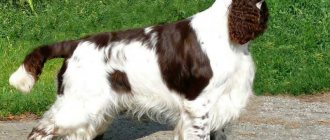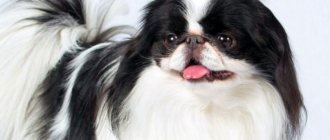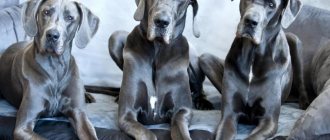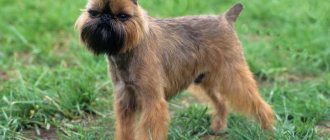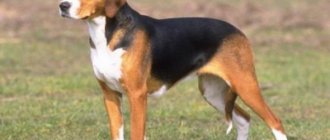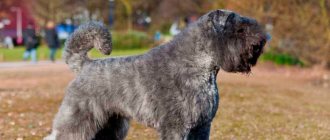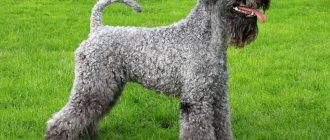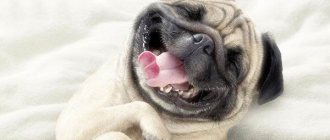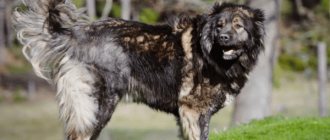- Dogs
Majestic, formidable and at the same time titanically calm, the Neapolitan Mastiff is a descendant of gladiators and an enviable pet of our time. Having changed many masks and roles, the modern Neapolitan Mastiff has become a “family man” and a guard, among close people, he can be clumsy and phlegmatic when faced with a dangerous enemy. Not many four-legged lovers decide to purchase such a large dog. If you still dream of a giant, you should understand and accept all the nuances regarding the breed in advance.
Origin story
The origin of the breed occurred more than two thousand years ago. The ancestors of the Neapolitan Mastiff are considered to be ancient fighting dogs - Molossian Danes. They were used to herd livestock and protect homes.
There is an opinion that the first mention of them appeared during the time of Alexander the Great. The Indian king, conquered by him, presented two puppies of this dog as a gift. In addition to India, images of similar large dogs were found at that time in Persia and Nineveh.
Breeders began breeding pure breeds much later. Pietro Scanziani was the first to introduce dogs to international dog shows in 1946. It showed 8 individuals with certain characteristics and traits.
NOTE!
After three years, the breed standard was approved. However, it underwent quite a few changes and the final version was adopted only in 1999.
Interesting facts about the breed:
- These dogs are not at all hasty. Dogs were formerly used to herd livestock such as buffaloes. Calmness and measuredness were required so that the bulls would not be frightened. This is where this quality came from in the breed.
- Mastiffs have voluminous fur with folds for a reason. During the times when they served as shepherds or fighting dogs, it served them as protection from attacks by wolves. Due to its large thickness it is difficult to bite through.
- Mastino puppies have a more fragile skeleton than decorative terriers. This is due to their size in the future. If a small dog has to grow twenty times in size, then Mastino puppies increase seventy times. The musculoskeletal system takes much longer to become stronger under such conditions.
- A dog of this breed, named Hercules, was listed in the Guinness Book of Records as the heaviest. He weighed 128 kilograms.
History of the breed
The Neapolitan Mastiff belongs to the Molosser group, one of the most ancient and widespread. However, there is a lot of controversy about the history and origin of these dogs. What is known for sure is that the Molossians were spread throughout the Roman Empire by the Romans themselves and the European tribes they captured.
There are dozens of theories about the origin of the Molosser, but they can be divided into five main groups of origin: from Central Asia, Greece, Britain, the Middle East and from the dogs of the Alan tribe.
Molossians were widely used by the Romans. They guarded livestock and property, were hunters and gladiators, and war dogs. They were mentioned by Aristotle and Aristophanes; they terrified the tribes of the Franks, Goths and Britons.
After the fall of the Roman Empire, they did not disappear, but were firmly rooted throughout Italy. During the Middle Ages and Renaissance, they served as guard dogs and were valued for their protective nature and ferocity.
Despite their long history, they were not a breed in the modern sense of the word. In different countries, mastiffs had to be crossed with different local breeds and the result was modern dogs.
In Italy, some lines were workers, others were guard lines. From the workers came the breed that we know as the Cane Corso, from the guards the Neapolitan Mastiff, although this name appeared in the 20th century, and the lines themselves were constantly crossed.
Popular among the upper class, Mastino Neapolitans were nevertheless not a common breed. Plus, the desire to get the largest dogs possible led to severe inbreeding.
Guard mastiffs served the upper class of Italy for centuries; thieves and robbers of all stripes could not resist these giants. They were gentle with their own and merciless towards their enemies. Dogs from the southern part of the country, near the city of Naples, were especially valued. They were said to be not only fierce and fearless, but also disgustingly ugly.
Their appearance shocked the strangers so much that they hurried to get away in a kind, healthy way, forgetting about everything. Southern Italy remained a stronghold of the aristocracy, while other parts of the country had republics and free cities. It was the aristocracy that could keep and breed these large dogs, but at the beginning of the 20th century social changes occurred.
The aristocracy has weakened significantly and, most importantly, become impoverished. It was already difficult to keep such dogs, but they managed to remain virtually unchanged until the outbreak of the First World War, despite the fact that there were no breed standards, clubs or shows.
Mastino was also lucky in that the First World War took place in Northern Italy, practically not affecting them. But World War II swept across the country, significantly reducing the already small dog population.
Warfare, devastation, and famine did not contribute to population growth, but nevertheless the Napoletano Mastino suffered from them to a lesser extent compared to other European breeds.
They had their fans who did not give up breeding even during the war. One of these people was Dr. Piero Scanziani, who created the breeding program, the breed standard and thanks to him it was recognized throughout the world.
Since the dogs have long been associated with the city of Naples, they decided to call the breed the Neapolitan Mastiff or Mastino Napoletano in their native language.
The breed was first presented at a dog show in 1946, and in 1948 Piero Scanziani wrote the first breed standard. The very next year it was recognized by the Federation Cynologique Internationale (FCI).
Until the mid-20th century, Neapolitan Mastiffs remained an indigenous breed virtually unknown outside Italy. However, since the end of 1970, individual individuals have found their way to Eastern Europe and the USA. Breeders were amazed by their size, strength and unique appearance.
However, the size and nature of the dog limited the number of people who could keep it and it remained rare. The breed was recognized by the United Kennel Club (UKC) in 1996, and the American Kennel Club (AKC) only in 2004.
Despite its growing popularity, the Mastino Napoletano remains a rare breed. So, in 2010 they ranked 113 out of 167 in terms of the number of dogs registered with the AKC. Most of them are used as companion dogs, but they also perform a lot of guard duty.
Their temperament has softened in recent decades, but they are still excellent guard dogs, with the strongest qualities of any mastiff.
Description of the breed
The Mastino Neapolitan is a huge, heavy dog. She has an intimidating appearance, but at the same time she is balanced. Height 65-70 cm, weight 50-60 kg, not lower. Female individuals are 15% smaller.
On the dog's head and face, characteristic folds form a peculiar pattern.
Mastino has strong bones, powerful muscles and impressive size. The dog has a wide and massive neck and a large short head. The Mastino has thick, hanging, triangular ears that are cropped.
In general, the dogs look brutal.
IMPORTANT!
Mastinos have stages of maturation. Up to 3 years old, a dog is considered young, up to 6 years old, and after that it is considered elderly.
Care
The average lifespan of a four-legged pet is 10-15 years, but these figures largely depend on proper care. Since the breed has features such as deep skin folds into which dirt will get trapped, the dog will need regular grooming in the area of skin wrinkles. Also, in the process of caring for a mastiff, the breeder will need to regularly perform such activities.
The animal needs to be massaged to disperse the blood under the skin. Such actions will help improve blood flow, which nourishes the dog’s coat. In addition, regular procedures will be an excellent prevention of eczema. You can perform a massage with your hands without using additional devices.
Some breeders use a hard mitten or brush made of silicone. All parts of the dog's body need massage except the face.
- After walking, you need to carefully examine the limbs of your four-legged pet. This is due to the likelihood of damage to the pads on the paws due to the fact that the Neapolitan has a rather sweeping gait. Having discovered any abrasions or wounds, the owner needs to treat them with a disinfectant composition.
- Due to the lack of undercoat in dogs of this breed, skin parasites can multiply in the “wrinkles,” especially in the summer. Therefore, in addition to inspection and cleaning, it will be necessary to treat the folds with compounds against blood-sucking pests.
- Your dog's ears will need weekly cleaning. For these purposes, you can use a cotton pad soaked in plain water or with the addition of an antiseptic. To prevent ear mites, it is recommended to use specialized drops for animals, which are sold in veterinary pharmacies.
- The dog is usually bathed in the warm season. For hygiene procedures, you can use hypoallergenic shampoo intended for children or animals. The rest of the time, cleansing the limbs, chest and abdomen with regular rinsing will be sufficient. After bathing, the dog should not be dried with a hairdryer; it will be enough to wipe the animal with a cotton towel. Frequent water treatments are not recommended for dogs, as they remove the natural protective fat layer on the animal's skin.
- Claws need to be trimmed as they grow; as a rule, such events are carried out monthly, using a special guillotine nail cutter. Only dead hollow tissue at the end of the nail can be removed. Cutting off a live area can cause blood poisoning, so the claw should not be disturbed under the plate.
When keeping a dog in an apartment, it is necessary to allocate a separate sleeping place, as well as a feeding area. The bedding or mat should be cleaned regularly, and no residue should accumulate in the dishes after eating.
Puppies of this breed can suffer from viral and bacterial diseases, so it is important for the breeder to carry out mandatory vaccination of the animal before 3 months. Usually the dog is vaccinated against hepatitis, distemper, leptospirosis and parvovirus
Up to 12 months of age, it is mandatory to vaccinate your pet against rabies. Then vaccinations are done every year. The optimal time for this procedure is spring.
Based on its physiology, the Neapolitan Mastiff is susceptible to the following ailments:
- volvulus, which most often occurs in adult dogs;
- cardiopulmonary filariasis, which is transmitted through the bite of blood-sucking parasites.
In general, the Neapolitan has a strong immune system, so it rarely gets sick. The dog will be most vulnerable in the first year of life, so the breeder is recommended to pay maximum attention to the pet.
The largest representative
Hercules is the largest and most famous representative of the breed.
In 2001, he was included in the Guinness Book of Records as the largest dog. By the age of 4, his weight reached 128 kg, and his neck circumference was almost a meter. This was twice the standard parameters of the breed.
His owner, the Englishman Mr. Flynn, says that the dog is like that by nature. He was not fed any special vitamins or supplements. He was the largest puppy of the litter and developed and grew quickly.
Mr. Flynn was given the idea for a record bid by a neighbor boy. After Hercules got into the book, journalists and reporters do not leave him and his owner alone.
Character traits
Despite their appearance, Mastinos are very good-natured dogs with a balanced character. They are also very loyal. The dog chooses one family member as its owner and remains devoted to him for the rest of his life.
The Mastino needs a territory to protect. They are excellent watchdogs and protectors. When a stranger appears in the house, the dog will be wary and will keep an eye on the newcomer. But as soon as he realizes that there is no danger, he will calm down and continue to behave as usual.
When walking, Mastinos also behave with dignity. The main thing is that there are no too loud passersby nearby. or gesturing sharply. The dog is always ready to defend its owner.
Mastinos can be shy. From early childhood they need to be accustomed to society so that in the future there will be no problems in communicating with people or other animals.
These dogs are friendly. They get along well with children. Many breeders call them “nannies” because the dogs show positive feelings towards babies and play calmly with them.
They are lazy, love to lie and watch, for which they were nicknamed “philosophers.”
Mastiffs can be jealous. It is worth carefully monitoring his behavior, as some show jealousy in the form of aggression.
Breeders note that the dog needs to be trained from the very beginning of its stay in the family. Although she is recognized as friendly and balanced, she must always understand who is boss. This must be done without aggression and violence, but firmly. You must not give in, otherwise you will live with the dog, and not the dog with you.
NOTE!
The Mastino is often compared to a human. These dogs have a calm and balanced disposition. They become very attached to people and need constant communication with them. During a conversation, they can give a response, sit next to you on the couch and watch TV with the owner. Therefore, it seems that it is not a dog nearby, but a person.
Training a Neapolitan
From early childhood, the puppy should be taught to be around people. Moreover, it is important that she contacts people both at home and outside. As a rule, there are no special problems with a dog outside the home. It is only important that those around you do not gesticulate.
This dog has excellent memory, observation, and restraint. She will try to accurately guess her owner’s thoughts, doing everything to earn his attention. When training, you should never beat a mastiff.
To express displeasure or reproach, you can simply raise your voice. In exceptional cases, you can simply slap your pet lightly on the back with a newspaper rolled up into a tube. The dog will immediately understand that he did something wrong and will try to smooth over the guilt.
All commands must be given to the dog in a firm and even voice, never raising it. The simplest commands for him are “Come to me!” or "Sit." When training your dog, you should ensure that it performs them automatically. Otherwise, she will decide that it will be possible to disobey the owner, and this will pass with impunity for her.
If a dog barks, there is no need to scold it for it. She does this to warn about something or simply performs her guard duties. Some dog breeders teach mastiffs to rush at enemies when given a signal: a word or even touching the animal.
During a walk, the dog may pull on the leash. To teach your animal to behave well during a walk, you need to wear a special collar with a chain. This device is quite rigid, but in a few weeks it will teach you not to pull the leash, and the dog will not have problems with this in the future.
When training a dog, you must remember that the behavior of all family members will be a model for it. Nothing will come of training if someone places restrictions on the dog, and another family member violates them. Before training, it is very important to familiarize yourself with the dog's pedigree. You should make sure that the dog’s parents are healthy and do not have any abnormalities.
Some owners practice walking without using a muzzle or leash, and teach the dog to rush at cats and even people. This type of behavior by dog owners is criminal. An improperly trained mastiff can become a source of danger to family members, despite its positive character traits.
Advantages and disadvantages
The positive qualities of the Neapolitan Mastiff include the following:
- Friendliness. You can have long conversations with them and be sure that they listen and understand what is being said.
- Devotion. They choose one owner once and for all.
- Good guards. Having such a dog, you don’t have to worry about your property. They have it genetically.
- Equilibrium. A properly raised dog will behave with dignity. They do not require noisy play and do not have the habit of getting underfoot.
The disadvantages include:
- Salivation. Due to the specific structure of the jaw and drooping cheeks, they drool profusely. During eating, this is also supplemented by food scattered around.
- Jealousy. Due to excessive attachment to the owner, Mastinos are jealous and can cause harm to others. Therefore, you should socialize your dog at an early age.
- Laziness. Those who like to lie down because of their heavy skin are slow and imposing. Dogs need to be forced to move periodically, otherwise there is a risk of becoming obese.
- Size. With its clumsy and huge body, the dog can unintentionally cause harm to surrounding things.
- House maintenance. Despite the fact that the Mastino is a guard dog, it is not advisable for it to live in an enclosure or on a chain. In such conditions, the dog will become aggressive and uncontrollable.
Character
Neapolitan Mastiffs have been guard dogs and bodyguards since ancient Rome. It is difficult to expect from them the character of a shepherd dog. They are usually calm and confident, but in case of danger they can turn into a fearless defender in the blink of an eye.
They love their owners and are surprisingly gentle with those they trust. Puppies are trusting and sociable at first, but grow into more private dogs. Those who are distrustful of strangers are definitely not those who greet everyone they meet.
Socialization is critical for the Neapolitan Mastiff. Those who have not been socialized grow into aggressive dogs, biting more often than others.
And their strength and size make bites a very serious matter. But remember that even ideal socialization cannot smooth out the thousand-year-old instinct.
Even the most trained mastino will attack strangers if they invade their territory while their owners are away from home.
They can be kept in families with children, however, most experts do not recommend this. These massive dogs can hurt a child even while playing. In addition, noisy and whiny games of children are aggression for them and they can react accordingly.
Finally, no child can be as dominant as required for this breed. If you need a bodyguard or watchman, there are few breeds that can do it better than the Mastino. But, if you have not had a dog before, then choosing a Napoletano would be a mistake. They need a firm hand and a strong-willed owner.
It is not a good idea to keep them with other dogs. Most Neapolitan Mastiffs do not tolerate dogs of the same sex, and some do not tolerate dogs of the opposite sex. Some people get along with the dogs they grew up with, but others can't stand them either.
It is extremely difficult to reconcile them with adult dogs, especially since the most striking feature of the breed is jealousy. They are very jealous and show their jealousy through aggression. And any tension between a mastiff and another dog will end sadly. After all, there are not many breeds that can withstand a fight with them.
They can be accustomed to cats and other animals, since they do not have a pronounced hunting instinct. However, they need to be trained as early as possible, since their guarding instinct makes them view other people's animals as a threat. They will definitely pursue strangers on their territory, remember that even if they love a domestic cat, this love does not extend to the neighbor’s.
Neapolitan Mastiffs are very intelligent and understand commands well, and can be obedient in the hands of someone they respect. A calm, confident and experienced owner will be satisfied with the process and result of training. This dog does something not because it is ordered, but because it respects its owner. And this respect must be earned.
They are dominant and are capable of placing humans below them in the pack hierarchy if allowed to do so. The owner must regularly remind the dog who is who and put him in his place. If the Neapolitan Mastiff believes that he is alpha, he will become willful and get out of control. A general obedience course is highly recommended for this breed.
If they are not on duty, they are surprisingly calm and relaxed, lying on the couch and not thinking about additional stress. They would prefer not to move once again, but they still need regular, moderate exercise. If they don’t receive one, they may get bored.
A bored mastiff is a destructive, aggressive mastiff. But, activity and stress should be moderate, especially for Neapolitan Mastiff puppies.
Puppies can develop musculoskeletal problems if the activity is excessive.
In addition, for adult dogs it is contraindicated immediately after feeding, in order to avoid volvulus.
There are other nuances that are not related to character, but which the potential owner will have to face. First of all, they salivate and there is no other breed that salivates in the same amount.
Threads of saliva flowing from the Mastino's mouth will be all over the house. Sometimes they shake their heads and then they can be found on the walls and ceiling.
Due to the structure of their skull, they are prone to gas and it is extremely unpleasant to be in the same room with a dog of this size who is experiencing flatulence. Proper feeding reduces it, but cannot completely eliminate it.
If drooling and gas scare you or your family, then you should definitely look for another breed.
Accepted Standards
Description of the breed standard:
- The head is large, short, with a lot of skin. It has many folds that hang down to the dewlap.
- The jaws are powerful, with a full set of teeth. Mite-type bite.
- The nose is wide, with open nostrils. Pigmentation depends on color.
- The eyes are round and wide-set. The color is slightly darker than wool.
- The ears are triangular, hanging, thick. Previously, they were subject to cupping due to possible diseases of the middle ear.
- The neck is strong and powerful. Middle length. It also has folds.
- The back is of medium length, but impressive width, with well-developed muscles. Slightly arched lower back.
- The limbs are strong and strong. Proportional to the body. Paws are voluminous, lumpy.
- The coat is smooth and short.
Disqualifying criteria include:
- undershot;
- a muzzle that is too short or a hump on the nose;
- short tail length or its complete absence;
- eversion or inversion of the eyelids, cataract, strabismus, white or colorless iris of the eye;
- aggression and cowardice;
- lack of suspension, folds;
- depigmentation of the nose;
- too large white markings in permitted areas or their presence on the head.
Appearance of the Neapolitan Mastiff
General impression
What does Mastino Neapolitan look like? At first glance, a dog of this breed is unfriendly and sullen. Strangers attribute to the dog excessive aggressiveness due to its large size, massive build and rough features. The first impression is wrong: even in the photo of the Neapolitan Mastino one can see his intelligent and calm look.
Head
Massiveness is characteristic of a square head with well-defined cheekbones. The flat skull is wide. The muzzle looks gloomy not only due to the presence of folds, but also due to the well-developed brow ridges and stop. Small, triangular-shaped ears fit snugly to the cheekbones.
The cheekbone muzzle is wide and deep. Round, deep-set eyes are set wide apart, the color is the same as the coat color, but several shades darker. Well-opened nostrils should be the same color as the dog's coat. The lips are large and cover the powerful jaws well. According to the standard, the animal must have a scissor bite.
Neck
The smoothly curved neck is short, cone-shaped, and at the same time muscular. According to the standard, a dog is allowed to have a dewlap up to the middle of its neck.
Torso
The body is long, slender and lean. The voluminous open chest is covered with skin so that the dog’s ribs are clearly visible. The back is straight, the lower back is wide and muscular. The muscles of the round, powerful croup are well developed; the hips are convex.
Forelegs
The front legs are positioned straight, parallel to each other. The bones are dense. Shoulders, shoulders, elbows, forearms are muscular. The wrists are dense and smooth. Pasterns are flat. The front legs are rounded and larger than the hind legs. Fingers gather into a ball. Dark dense claws are well curved.
Hind limbs
Powerful hind legs allow the Neapolitan Mastiff to push well. The thigh muscles are dense and demarcated. The legs are distinguished by strong bones and well-developed muscles. The hock joints are well defined. The metatarsus is characterized by a cylindrical shape. The rounded paws gather into a dense lump. The pads are dry and highly pigmented. The description of the claws is the same as on the forelimbs.
Tail
The long tail tapers from base to tip and is set high. Docked; when undocked it reaches the hock joint. When the dog is calm, the tail hangs calmly; if the animal is excited, it raises its tail above its back.
Movement
The specialty of the breed is movement. Mastino Neapolitan moves slowly, with cat-like grace. While running, it pushes thoroughly with its hind limbs. Usually walks and trots, but ambling is also allowed.
Wool
The density of the hard and smooth coat allows dogs to withstand cold weather. The hairs fit tightly to each other, forming a kind of fabric. The standard does not allow curls or fringes.
Color
What colors can predominate in Mastino Neapolitan colors? The following types of colors are characteristic of the Italian Mastiff: gray, black, reddish, a mixture of yellow and brown. There may be tan or brindle marks on the coat.
Size
The Mastino Neapolitan is a large breed dog. To some extent, due to its size, the dog is not suitable for novice dog owners. An adult dog weighs from 50 to 70 kg (the final weight of a Mastino Neapolitan depends on age and build). The height at the withers of girls reaches 68 cm, the height of a Neapolitan mastiff boy reaches 72 cm. It is allowed to exceed the norm by 2 kg. It is important to monitor the development of the puppy, and if he is not gaining weight well or is growing slower than other babies from the litter, you need to contact a veterinarian.
Photos with examples of colors
Neapolitan Mastiffs come in the following colors:
- black;
- grey;
- blue;
- Red tree;
- Isabella (average between fawn and gray).
There are individuals with several colors, smoothly transitioning from one to another. There may also be white markings on the chest and fingers, which is not a fault.
Bitch: character
There is an opinion that Mastino Neapolitan females have a more submissive and gentle character. But experts believe that character largely depends on heredity and individual characteristics. There are always exceptions, bitches with a very difficult character, and there are males with an easy-going and submissive character. But still, there is a difference in the behavior of the sexes. There are advantages and disadvantages for female and male genders.
Advantages:
- Strong relationship with owner and home
- Emotionally sensitive perception
- Girls are smarter and smarter than boys
- Accepts training tasks well
- During walks, he runs less in the bushes
- Doesn't rush at strangers
- The breed is ideal for breeding, just one assessment from the exhibition is enough
Flaws:
- Sly
- Periodic menstruation
Where is the best place to keep it?
As noted above, these dogs are not suitable for keeping on a chain or in an enclosure. The ideal place for them to live is at home. There they are close to the person, but at the same time they have enough space and have the opportunity to spend time outside without strangers.
As for the apartment, opinions differ. If the apartment is large and spacious, then it is quite possible. Many owners keep it this way. The main thing is that both you and the dog feel comfortable.
Caring for Mastino Neapolitan
Mastino should not be bathed frequently, only washed when necessary. Being a heavy dog, this breed is prone to joint diseases such as hip dysplasia. Mastino is characterized by increased salivation. When eating and drinking, the dog is sloppy - everything scatters around, so bowls should be placed on an easy-to-clean surface.
For sleep and rest, the dog must have soft bedding. When lying on the floor, the dog can hit it with its elbows, causing damage to the joints. Of course, keeping such a dog in an apartment is very difficult. She needs a lot of space and also needs long walks with exercise.
Photo source: dogcentr.ru
Pharaoh Hound: history of the breed, character and care...
Integrate Pravda.Ru into your information flow if you want to receive prompt comments and news:
Subscribe to our channel in or
Add Pravda.Ru to your sources in Yandex.News or
We will also be glad to see you in our communities in
Attitude towards other animals and children
Mastinos are phlegmatic and friendly. They are calm with children, cats and other dogs.
Breeders who have children call their dogs nanny dogs. Mastino is able to put the baby to sleep, cheer him up or look after him on a walk, in addition to his protection and protection. But it is worth remembering that dogs are susceptible to jealous feelings and can show aggression.
General characteristics of the breed
A dog with a massive appearance actually has a friendly character, easily makes contact and takes part in all active games with pleasure. Nanny dog, this is what Mastino Neapolitan is called in its homeland. The breed is attached to its owner and takes care of him and every member of the family all his life. It’s not scary to leave a stroller or a playing child next to your dog. The huge dog will not only not harm the child, but will also ensure his safety. But it’s better to get a dog after the baby is born. The dog has a jealous character and cannot stand competition for the love of its owner. In some cases, the dog shows jealousy in an aggressive form.
How to care?
The dog should have a place in the house where it can sleep. Buy bedding to prevent joint diseases. Since the dog is sloppy, it is advisable to place easy-to-clean material under the bowls.
Walk
They need daily long walks twice a day. In addition to the surrounding area of the house, they require walks in parks and specially designated areas for dogs.
Mastino does not tolerate hot weather well, since a particularly large organism does not have time to cool itself. In summer, on very warm days, it is better to walk the dog in the early morning and late evening, when the temperature is significantly lower.
Wool
Mastiffs need to be brushed weekly. Since they have very delicate skin, prone to irritation, itching and dandruff, they are bathed only when necessary or before exhibitions. The shedding period lasts 10-14 days, during these days it is necessary to comb every day.
IMPORTANT!
Mastino belongs to the “drooling” breeds. It is necessary to accustom the dog to regular procedures for wiping off drool, otherwise the chin will become a breeding ground for infections.
Ears and eyes
Ears and eyes are examined every 4 days.
Dogs' ears have weak muscle tissue and are prone to frequent inflammation, so they are constantly cleaned with special lotions and cotton swabs. If inflammation is present, you can use special powders to combat the disease in the initial stages.
It is prohibited to bathe dogs under one year of age, as water can get into the ears, which can lead to inflammation of the middle ear.
The eyes are also wiped with a special lotion if necessary. Although this breed rarely suffers from eye diseases, attention must be paid.
Teeth
An equally important procedure is brushing your teeth. Plaque and tartar can damage the gums and tooth necks. You need to purchase a special toothbrush and toothpaste and carry out the treatment a couple of times a week.
Claws
If there is no natural grinding of the claws, a special guillotine nail clipper for large breeds is used. It is also necessary to inspect the paws after walks. Due to the soft pads of the fingers and the peculiar structure, small branches and stones can get there.
Care and maintenance
It is worth considering that the mastiff is not an indoor breed. It can be kept in an apartment, but a house with a large plot is better suited, where it will have greater freedom of action for successful development. In addition, the pet cannot be chained. As already noted, the dog needs free space for harmonious development, and on a chain the mastiff will become an angry and aggressive dog.
- The mastiff's habitat should be equipped. It is best to purchase medium-hard bedding. The main thing is that it is not soft, as this causes problems with the joints and bones of the animal. However, too hard will cause future bald patches.
- Provide your dog with free access to toys . However, they should not be too small, as the mastiff may choke.
- Clean water should also always be available.
- A dog of this breed requires a lot of attention. You need to walk her at least 2 times a day. Walks are usually calm. However, walking with zero activity can cause certain health problems over time. Therefore, the Neapolitan Mastiff needs to be forced to run at least sometimes.
- It is important to brush your Mastiff's teeth regularly. Since the breed is predisposed to diseases such as tartar. It causes damage to the gums and necks of teeth. A special toothbrush and toothpaste will help you avoid the problem; you need to use them 1-2 times a week. Such procedures should be carried out from the first month of a Neapolitan mastiff’s life.
- In addition to the teeth, this dog's ears are at risk. Due to the lack of a developed muscular and cartilage system, they require constant care. To clean your ears you need a special lotion and cotton swabs. If you suspect ear inflammation, you can buy special powders that will help fight the disease at an early stage.
- The last problem area to consider is your pet's eyes . Although such diseases are quite rare for the mastiff, they can cause serious consequences. Therefore, if your eyes become excessively teary, you should immediately begin treating them with a special lotion.
Nutrition
Small Neapolitan Mastiff puppies, aged 2 to 4 months , need to be fed at least 4 times a day . It is recommended to give the puppy milk formulas that are similar in composition to mother's milk. When a puppy develops teeth, its needs for microelements increase. Therefore, proper supplementary nutrition must be provided by this time.
The frequency of feeding depends on the age and activity of the pet, but you can focus on the indicated intervals:
| Age | How often to feed, once/day |
| 2-4 months | 5 |
| 4-6 months | 4 |
| 6-10 months | 3 |
| over 10 months | 2 |
The Neapolitan Mastiff has an excellent developed gastrointestinal tract, which makes it easy to provide an adult with everything necessary and avoid many problems.
An adult mastiff is no longer so picky about food. Therefore, it is enough to feed him once a day and it is better to do this in the dark. At the same time, the diet should be varied and have enough protein-rich foods.
If it is not possible to provide your pet with all the necessary minerals and vitamins, then you can use special supplements and dry food. You can buy them at any zoological store.
It is recommended to feed your pet regularly and at the same time. In addition, the mastiff should have free access to clean water. When buying food for your dog, you should exclude rice and chicken. They have a bad effect on digestion due to the fast metabolism of this breed.
Health
Despite a fairly strong body and a fairly high resistance to many infections, these dogs have a tendency to develop heart pathologies, hip dysplasia, nervous disorders, and allergic reactions.
A particularly dangerous parasitic disease is cardiopulmonary filariasis, the symptoms of which often appear late.
Vaccinations
Mastiffs are vaccinated with a complex vaccine that works against several diseases at once:
- coronavirus;
- parovirus enteritis;
- plague;
- trichophytosis;
- hepatitis;
- parainfluenza;
- rabies;
- leptospirosis.
A week before vaccination, a dog of any age is treated for helminths. Adult mastiffs are vaccinated once a year, babies - twice (usually at 8 and 12 weeks).
After the procedure, puppies of this breed are subject to a 2-week quarantine, not being allowed to walk outside during this time.
You should also carefully monitor your pet's condition, contacting your veterinarian if complications arise.
Diseases
The first thing you need to pay attention to after purchasing a Neapolitan Mastiff puppy is physical activity. The fact is that the breed is prone to laziness in the absence of a clear incentive, and this is fraught with some complications. The most harmless thing is obesity.
However, it is also easy to avoid. You just need to control the amount of food. A much more unpleasant deviation is pain in the joints. They do not have time to strengthen in accordance with muscle growth and become vulnerable to mechanical damage.
The Neapolitan Mastiff is predisposed to the following diseases:
- joint dysplasia, with a claim of osteoarthritis;
- cardiomyopathy is a hereditary disease;
- demodicosis (main pathogens are mites);
- pyoderma (skin disorder);
- allergies of various etiologies;
- dermatitis, often spread by fleas;
- filariasis (a dangerous disorder of the pulmonary system);
- helminthic infestations.
The development of these and other diseases can be prevented if you regularly visit the veterinarian and carry out all the necessary examinations of your pet.
Walk
Mastiff dogs cannot be classified as active animals. They are quite lazy and phlegmatic. But this does not mean that you can let them lie dormant. The dog must be walked at least 2 times a day, walking for at least half an hour.
Due to poor thermoregulation, this breed may experience heat or sunstroke during active walks in the open sun in the summer. Therefore, on hot days you should reduce the time you spend outside and stay in the shade with your dog.
You need to play with your dog or train it outside as often as possible to provide additional physical activity. This regime will ensure normal physical development and good health for the mastiff.
Grooming
- The coat of mastiffs is very short and smooth, covered with a special fatty layer that protects the animal from the bites of various insects. Therefore, there is no need to comb it, except during the molting period.
- Shedding lasts from 10 to 14 days and during this period it is advisable to comb out the old fur daily. The beginning of shedding is easy to notice by the scraps of fur that appear in the house and by the dog’s more thorough licking of itself.
- Until the mastiff turns 1 year old , bathing her is strictly prohibited to avoid water getting into the ears, which are still developing. This can cause inflammation and infection.
- Representatives of this breed should be bathed very rarely and only in exceptional cases when bathing is indispensable. The fat layer on the surface of the coat is washed off with water and shampoo, especially if water treatments are abused. This will make the dog defenseless against insects on the street.
Health and illness
With proper maintenance, the life expectancy of mastiffs is 8-10 years.
Despite their strong bodies, dogs still suffer from a number of diseases:
- joint diseases (hip dysplasia)
- hereditary heart diseases (cardiomyopathy)
- skin diseases (dermatitis, irritation, itching)
- helminthic infestations
- filariasis (lung disease)
- various allergic reactions
It is necessary to do all vaccinations on time and undergo periodic examinations by a veterinarian.
Health
On average, a Dogo Italica can live 9-10 years.
Mastiffs often have the following health problems:
- Demodicosis - affects the skin and internal organs, the causative agents are mites.
- Joint dysplasia – accompanied by severe pain, lameness and immobility.
- Pyoderma is purulent skin lesions.
- Cardiomyopathy is a disease of the heart muscle, more common in male dogs.
- Hypothyroidism is a dysfunction of the thyroid gland.
- Entropy is an incorrect position of the eyelid, which is eliminated by surgical intervention.
- Progressive retinal atrophy – if left untreated, can lead to vision loss.
- Difficult childbirth - often difficulties arise during childbirth, and as a result, you have to resort to a caesarean section.
Most diseases are caused by improper care and inattention of the owner to his dog. Health problems can usually be noticed by the condition of the animal. A sick dog becomes lethargic, drowsy, and his activity and appetite sharply decrease.
Many diseases can be avoided if you vaccinate on time, treat your dog for parasites and show it to a veterinarian for preventive examinations.
What and how to feed?
Small Mastino puppies aged 2-4 months should be fed formula milk similar to their mother's milk. The number of feedings is at least 4 times a day.
After 4 months, you will need to introduce the following products into your diet:
- boiled eggs;
- raw liver;
- plain yoghurts;
- yeast;
- fish fat.
By the age of 10 months, the number of feedings is reduced to 2. An adult must be fed once and preferably in the dark.
The Mastiff is unpretentious in food; its stomach accepts almost any food. The only thing that should be excluded from his diet is chicken and rice. You can also add a variety of mineral and vitamin supplements if necessary.
Neapolitans can also be fed ready-made balanced food. But with this method of feeding, it is important to provide the dog with constant access to water.
Education and training
Raising and training a Neapolitan Mastiff is a rather labor-intensive process, since the animal relies more on an emotional connection with its owner-trainer rather than remembering commands thanks to its sharp mind. Having established a strong connection with the pet, based on mutual trust and friendly feelings, the owner will notice how the baby turns into a proud dog who is ready to protect him in any situation. Do not forget that the descendants of Molossians are vindictive: you should never yell at a dog, much less beat it, as this is fraught with consequences.
It is important from the first minutes of being in a new home to teach a Mastino puppy to respond to the nickname given to it. This exercise will ensure that the animal will be able to pay attention to the owner.
How to raise an Italian Mastiff? You need to understand that praise is the best assistant in this difficult matter. Raising a dog begins at the age of one and a half months. The dog masters basic commands, without which his presence in the house will cause a lot of trouble: “ugh”, “come to me!”, “place!”. At this stage, the questions “how to train a mastiff to go to the toilet on the street”, “how to stop an animal from chewing shoes” are solved.
Is it possible to take a two-month-old puppy to courses? Serious training begins between the ages of three months and six months. Completing a basic training course is necessary to develop qualities such as patience and obedience. During these lessons, the dog undergoes socialization, learns basic commands (“sit!”, “lie down!”, “stand!”), masters fetching and some exercises with implements.
Attending protective guard service courses is not necessary for pets if the owner does not want to make him a watchman.
A well-mannered and trained Neapolitan Mastiff will never attack passers-by, will not bark for no reason, and will always come to the aid of the owner and members of his family.
How to choose a puppy?
When choosing a puppy, you need to decide for what purpose you are getting the dog. Will the dog be an exhibitor, a breeder, or just a friend to keep at home? With the first two options, it is better to contact trusted breeders or a nursery. It is impossible to run into low-quality breed there.
The puppy must be healthy, active, determined, but not aggressive. Must also conform to breed standards in appearance. You need to examine your ears and eyes for inflammation. There should be no combed areas on the animal's skin.
NOTE!
It is necessary to check the availability of all necessary documents and veterinary vaccination certificates.
The gender of the puppy is chosen according to your taste. But you need to know that girls will have to bear offspring in the future, and childbirth in this breed is difficult. Therefore, you should seriously think about what gender of puppy to buy.
The most famous nurseries in Moscow and St. Petersburg:
- Rus Lago Maggiore.
- Gwydion.
- Anvira.
- Notte Bianca.
Pet health
Mastino Neapolitan puppies are susceptible to various viral and bacterial diseases. Before three months, it is necessary to carry out the first vaccination against diseases: leptospirosis, hepatitis, plague and parvovirosis. Up to a year, the pet is given an additional rabies vaccination. Vaccination is carried out throughout the life of the animal, once a year. It is better to vaccinate an animal in early spring or late winter.
Before vaccination, the dog must be treated for internal and external parasites. Treatment is carried out with one of the following drugs: Dironet "Spot-On" from Agrovetzaschita (drops on the skin in the withers area), Alben S (tablets for worms), Prazitsid-Suspensiya Plus (suspension for oral administration against worms), Helmimax-20 (tablet form from 13 types of parasites).
According to physiological characteristics, the breed is susceptible to diseases:
- cardiopulmonary filariasis. Transmitted through blood-sucking insects;
- intestinal volvulus. Occurs in dogs over five years of age. Rest after eating helps prevent this; the animal is not allowed to run or play active games.
